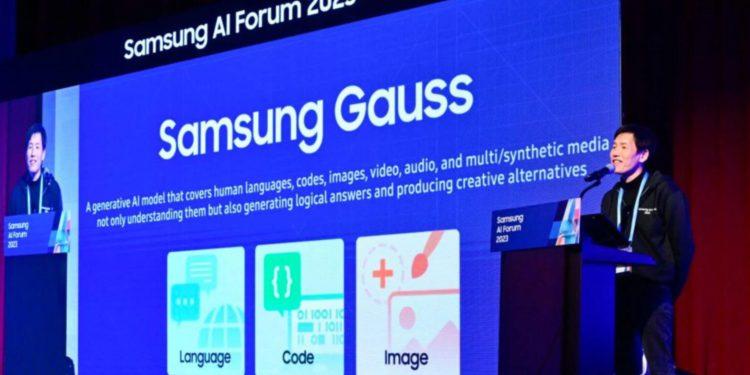Samsung has publicly unveiled its in-house generative AI model known as Samsung Gauss. The company announced it during the Samsung AI Forum 2023 event held at the Samsung Advanced Institute of Technology in Seoul, South Korea.
The AI model is named after renowned mathematician Carl Friedrich Gauss, known for establishing the Normal Distribution Theory, a fundamental concept in the field of Artificial Intelligence and Machine Learning.
The South Korean tech giant introduced Samsung Gauss after filing a trademark application in September. During the event, details about the generative AI model were shared.
At the Samsung AI Forum held in Seoul, the tech giant disclosed that the primary development goal of Gauss was to enhance employee productivity within Samsung Research. However, the company plans to extend the applications of this generative AI model to various products in the near future.
Samsung’s vision for Samsung Gauss is to leverage AI’s capabilities to improve consumers’ lives by tapping into the wealth of knowledge and phenomena worldwide.
The Samsung Gauss model comprises three vital components: Samsung Gauss Language, Samsung Gauss Code, and Samsung Gauss Image. The Samsung Gauss Language segment is specifically tailored to boost work efficiency, aiding in tasks like email composition, document summarization, and language translation. Furthermore, it can potentially elevate consumer experiences by enabling smarter control over devices.
Samsung’s Gauss Language model operates on cloud servers and endpoint devices, encompassing mobile phones, tablets, and personal computers. With its capability to comprehend human language and generate responses, this component promises improved productivity and enriched user interactions.
The Code component of the Samsung Gauss model, complemented by its coding assistant named code.i, focuses on in-house software development initiatives. It is a supportive tool for developers, offering an interactive interface that simplifies the coding process.
This combination streamlines coding tasks, making them more efficient and swift. Code developers can benefit from features like code description and test case generation, contributing to a smoother development experience.
Their interactive interface facilitates coding processes and helps functions like code description and test case generation. These tools are expected to support developers to code with agility and ease.
The third component, Gauss Image, allows users to edit and generate images. It possesses functionalities, including image enhancement from low-resolution to high-resolution, style transformation, and adding various elements. The component adds a layer of image processing capability to the Gauss model, promising a versatile tool for image manipulation and generation.
Samsung is actively working on on-device AI applications that prioritize protecting users’ private information. Additionally, the company has instituted its AI Red Team, dedicated to ensuring the secure and responsible use of AI. The AI Red Team’s mission involves the identification and resolution of security and privacy challenges that may arise throughout various stages of AI implementation, including data collection, model development, service deployment, and results generated by AI applications.
Samsung’s next-generation flagship devices will likely incorporate the Gauss model, enhancing user experiences with innovative AI capabilities.
Also Read:
- High-Stakes Legal Battle: Samsung Display Accuses BOE of Trade Secret Breach
- Top 6 Gen AI Projects from South Korean Tech Giants
- KT Unveils Mi:dm AI Model with 200 Billion Parameters for Diverse Applications
- Naver and Samsung Collaborate with Korean Govt for International AI Safety Summit
- Samsung Announces Global Rollout of ‘Temporary Cloud Backup’






